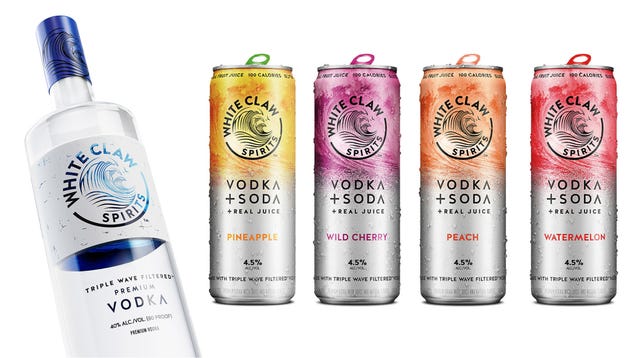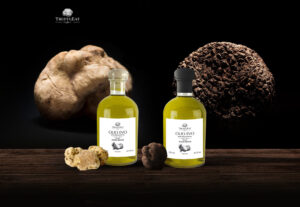It’s been clear for a while now that the world doesn’t need another hard seltzer—but does it need more vodka? White Claw thinks so. Rather than continue adding solely to the oversaturated market of flavored malt beverages billed as hard seltzer, the brand has announced that it will expand into the vodka category.
White Claw’s newest drinks in 2023
Not only has White Claw chosen to break into vodka, but it’s doing so from a few different angles; the brand has strategically chosen multiple entry points to court various types of consumers. The headliner is White Claw Premium Vodka, which features “a minimal yet complex combination of aromas and sensations in the mouth and nose—subtle notes of citrus at first, then grain, then a velvety finish.” It’s available in select markets across North America.
Beyond the straightforward vodka product, White Claw is also releasing White Claw Flavored Vodka in mango, black cherry, and pineapple flavors. Whereas the original product has 40% alcohol by volume, the flavored vodka contains 30% ABV. Both the regular and flavored vodkas will be available in 1L, 750ml, and 50ml bottles.
Finally, White Claw is also pushing its portfolio in the direction of ready-to-drink (RTD) cocktails with White Claw Vodka + Soda in pineapple, peach, wild cherry, and watermelon flavors. This product makes use of the same White Claw Premium Vodka that’s being sold by the bottle; each 12-oz. slim can has 100 calories and 4.5% ABV and is sold in variety 8-packs or single-flavor 4-packs. Canned RTD beverages first began to dethrone hard seltzer last summer, and the category has only grown since.
Why White Claw is moving into vodka
You might wonder why White Claw is only getting around to making vodka and canned vodka sodas in 2023. The timing of this move—a huge one in the brand’s relatively short seven-year history—comes down to legal limitations.
Back in 2020, the Alcohol and Tobacco Tax and Trade Bureau changed its definition of vodka. Previously, the spirit had to be essentially a blank slate, meaning it was “without distinctive character, aroma, taste, or color.” By contrast, the new definition notes that vodka “may be treated with up to two grams per liter of sugar and up to one gram per liter of citric acid.” Translation: Vodka can now get all gussied up with fun flavors and still be legally categorized as vodka.
Although White Claw’s press release does not explicitly describe the new flavored vodka as containing sugar, the brand is forthcoming about how the change in regulations presented a business opportunity. It’s evident that the company was eager to take advantage of the bureau’s newly relaxed definition.
“We believe that quality vodka shouldn’t be defined by what it lacks, and we seized the enormous opportunity to create a distinctive spirit,” Anthony von Mandl, Founder & CEO of The Mark Anthony Group of Companies (which makes White Claw), said in the press release.
Furthermore, White Claw’s decision to move into RTD cocktails follows current industry trends and lets the company diversify its offerings. Yet within the RTD category, tequila, not vodka, is leading the way in 2023. Morning Brew reports that the vodka industry’s sales remained flat last year at $7.2 billion, and Forbes reported in November that tequila was outpacing vodka in sales. Although tequila remained behind whiskey and vodka in terms of pure popularity, it was also the only spirit category to experience more than 1% year-to-date growth, per Forbes.
White Claw has been credited as the pioneer of the hard seltzer boom, so it’s not unreasonable to think it might be able to breathe new life into vodka. Watch out, Tito’s.

